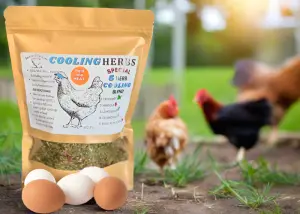
Most people do not know how to properly clip chicken wings. There are both pros and cons to clipping a chickens’ wings. Some chicken owners will routinely do this to protect their flock, but then there are others that think it is a very cruel act. In certain situations and if done properly, trimming a chickens’ primary feathers can be very beneficial to your flock.
This Article Will Cover:
- Pros and Cons of Trimming a Chicken’s Primary Feathers
- How to Properly Clip Chicken Wings (With Simple Step by Step Instructions)
- What to Do If You Cut a Blood Feather
- FAQ Regarding Clipping a Chickens Primary Flight Feathers
Pros and Cons of Trimming a Chicken’s Wing Feathers

Pros of Clipping Chicken Wings
PRO: Trimming a chicken’s wing feathers can keep it inside the safety fencing. If it can fly over your safety fencing, it is at risk of being attacked by predators, such as dogs, fox, coyotes, birds of prey, etc. If you do not have any other way of keeping your chickens from hopping your safety fencing, then you should clip one of its wings. This will keep it safe inside of the enclosure.
PRO: Clipping your chicken’s wings is temporary. If you decide you don’t want your chicken’s flight feathers trimmed, it will grow back during the next molt. Chickens molt 1-2 times a year.
PRO: Clipping your chicken’s flight feathers is painless. It is the equivalent to trimming the dead part of your finger and toe nails off.

PRO: You will not have to hunt for their eggs. Some chickens will fly over the fence and seek out a hidden spot to lay its eggs.
PRO: You will not have to chase after your chickens to bring them back inside their safe enclosure.
A full grown chicken with its wings intact is able to get up off the ground, high enough to fly over a 6 foot fence. It can’t fly very far though, maybe a distance of about 10-15 feet. If you are having a problem with your chickens escaping their safe enclosure, clipping one of their wings is highly effective.

Cons of Clipping Chicken Wings
CON: Trimming a chicken’s feathers will make it land harder when getting down from its roosting bar, predisposing it to breaking it’s leg bones.
- SOLUTION: Provide additional roosting bars for the chickens to jump onto to get down from the highest bar. Don’t put roosting bars higher than 4 feet off the ground.
CON: Trimming a chicken’s primary flight feathers will make it more difficult to get away from a predator.
- SOLUTION: Make sure that your chickens are securely locked inside their coop at night. In the daytime, make sure that their fencing protects them from being able to get out and that it also protects them from predator attacks from up above. Common birds of prey that will attack a chicken are hawks, owls and eagles.
For more information on how to protect your chickens from common predators and how to identify what attacked your chickens, read my article 11 Common Backyard Chicken Predators – How to Best Prevent Attacks.
How to Clip a Chicken’s Wings So They Can’t Fly

Step 1: How to Properly Clip Chicken Wings
If you are alone, hold your chicken in your lap, facing away from you. If you have someone to help you, have them hold the chicken facing towards you.
Step 2: How to Properly Clip Chicken Wings
Fan one wing out. You only need to trim one. Clipping one wing of a chicken will unbalance it during flight, not allowing it to fly as high.
Step 3: How to Properly Clip Chicken Wings
Identify the primary and secondary feathers.
- Primary Feathers: These are the chicken’s flight feathers. They are the longest and strongest feathers on a chicken and are the outermost 10 feathers on the wing. These are the feathers that you will be cutting. They are more pointed, compared to the secondary feathers. (There are shorter, rounder feathers that lie on top of the primary feathers.)
- Secondary Feathers: These are the inner flight feathers (closer to the body). They are shorter and not as strong as the primary wing feathers. They help keep a chicken in the air, giving it “lift.” Most chickens have 14 secondary feathers. These feathers also help to keep a chicken warm. So you want to make sure that you don’t clip these!
Step 4: How to Properly Clip Chicken Wings
Holding the chicken in your lap, make sure its opposite wing is tucked down. You want to make sure that the chicken is gently restrained, so it doesn’t start flapping around during the wing clipping. Chicken wing bones are very delicate and can break easily.
Step 5: How to Properly Clip Chicken Wings
Gently secure the hen to stay down by reaching your non-dominant forearm across the chicken and hold its wing fanned out with this same hand.
Step 6: How to Properly Clip Chicken Wings
Use a pair of sharp scissors to cut the 10 outermost feathers. These are the primary feathers.
- Cut AWAY from the chicken’s body.
- Cut just below the shorter overlying feathers. Some choose to cut only 1/2 of these feathers off. This is fine, but you will need to cut more frequently.
- If you cut into the feathers that lie above the primary feathers, your chicken will bleed.
- See Image Below:

What to Do If You Cut a Blood Feather
It is important not to cut too far up into the primary covert feathers when you are cutting the primary flight feathers off. If you find that you have cut into a blood feather, you will need to stop it from bleeding right away.
All feathers have a continuous blood supply in order to grow and this is delivered through the shaft of the feather. As feathers age, the blood supply will recede. This is why it is safe to cut the primary flight feathers off, right below the primary covert feathers.
A chicken first aid kit should contain something to help stop bleeding. Kwik Stop Styptic Powder or cornstarch will work to stop a bleeding blood feather. If you do not have any of these on hand, flour will work in a pinch.
For a list of what you should keep in your chicken first aid kit, read my article What Do I Need in My Chicken First Aid Kit?
Broken blood feathers can be very painful for a chicken and a very scary experience for them. They may flail around flapping their bloody wing, making it even worse.
Have a chicken “time out” cage available so you can isolate it if it has a broken blood feather after you treat it.

How to Stop a Blood Feather from Bleeding
- Stay calm. Your chicken can pick up on your emotions. This will help to calm the injured chicken.
- Pick up your chicken and apply a blood clotting agent such as Kwik Stop Styptic Powder or cornstarch to the bleeding feather. It is important to stop bleeding as soon as possible. A chicken does not have very much blood, so losing any amount of blood can be deadly to a chicken.
- Apply pressure with a clean cloth or gauze pads to the bleeding feather for 10-15 minutes.
- In most cases, this should stop the bleeding.
- Once the bleeding stops, place the chicken in an isolation cage where you can keep an eye on it.
- After 1 hour without any bleeding, you can let your chicken back in with the rest of the flock.
If you find that the bleeding doesn’t stop, you will need to remove the feather. This is VERY painful for a chicken. If you don’t feel comfortable doing this yourself, consult a veterinarian.

How to Remove a Bleeding Blood Feather
- Stay calm. Remember that your chicken can feed off of your emotions. If it senses your stress or panic, it is more likely to panic too.
- Securely hold the chicken. With one hand, put pressure on the base of the bleeding feather. With the opposite hand, tightly grip the feather close to the base and quickly pull it straight out with pliers. This should stop the bleeding. If there is any more blood, apply pressure for a few minutes or until the bleeding completely stops.
- Clean up any remaining blood and apply an antiseptic spray to where you removed the feather.
- Make sure that when returning a chicken back with the rest of your flock that there isn’t any blood showing. Blood will especially show up on lighter colored birds. Chickens go crazy over blood and will peck a flock mate to death if there is any sign of blood.
It doesn’t take much blood loss for it to effect your chicken physically. If there has been considerable blood loss, offer your chicken some electrolytes to help perk it up.
For more details on how to pull a blood feather you can read this article from WikiHow, How to Pull a Blood Feather.





